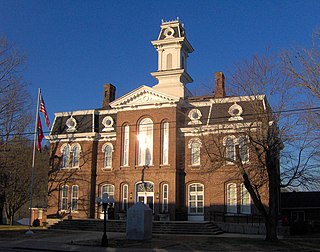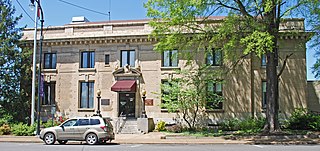
Sevierville is a city in and the county seat of Sevier County, Tennessee, United States, located in eastern Tennessee. The population was 17,889 at the 2020 United States Census.

The Cumberland County Courthouse, located in Courthouse Square in Toledo, is the county courthouse of Cumberland County, Illinois. Built in 1887–88, the building is Cumberland County's second courthouse. The first courthouse, located at the same site as the current one, was built in 1856 and burned in 1885. The second courthouse was designed by architects S. S. Goehring and L.L. Pierson. The building's design features a central clock tower, arched entrances on the east and west sides, column-supported balconies above the entrances, and a balustrade along the roofline. The building has continuously served as the seat of county government since its opening.

The Rhea County Courthouse is a historic county courthouse in the center of Dayton, the county seat of Rhea County, Tennessee. Built in 1891, it is famous as the scene of the Scopes trial of July 1925, in which teacher John T. Scopes faced charges for including Charles Darwin's theory of evolution in his public school lesson. The trial became a clash of titans between lawyers William Jennings Bryan for the prosecution and Clarence Darrow for the defense, and epitomizes the tension between fundamentalism and modernism in a wide range of aspects of American society. The courthouse, now also housing a museum devoted to the trial, was designated a National Historic Landmark in 1976.

The old Roane County Courthouse building in Kingston, Tennessee, the county seat of Roane County. Built in the 1850s, it is one of six remaining antebellum county courthouses in the state of Tennessee.

The Downtown Greensburg Historic District in Greensburg, Kentucky, the county seat of Green County, is a historic district on the National Register of Historic Places. It consists of 47 contributing properties.

The Cannon County Courthouse located at Court Square in Woodbury, Tennessee, is an historic building and the center of county government in Cannon County.
Mosby Tavern, also called Old Cumberland Courthouse or Littleberry Mosby House, is a National Register of Historic Places building in Powhatan County, Virginia. Located southeast of the intersection of U.S. Route 60 and State Route 629 in Powhatan County, Virginia, with a street address of 2625 Old Tavern Road, it began as a small one-room house built by Benjamin Mosby in 1740, and remains a private residence today.

Davidson County Courthouse, also known as Metropolitan Courthouse, is an Art Deco building built during 1936–37 in Nashville, Tennessee. It was listed on the National Register of Historic Places in 1987.

The Joel W. Solomon Federal Building and United States Courthouse, commonly referred to as the Solomon Building, is a historic post office and courthouse located at Chattanooga, Tennessee in Hamilton County, Tennessee. The courthouse serves the United States District Court for the Eastern District of Tennessee. The building is listed on the National Register of Historic Places as U.S. Post Office. It was designed by Shreve, Lamb and Harmon and Reuben Harrison Hunt with watercolor murals by Hilton Leech.

The Cumberland County Courthouse is a historic courthouse building located at Cumberland, Cumberland County, Virginia. It was built by Dabney Cosby, a master builder for Thomas Jefferson, in 1818. It is a brick, one-story, rectangular, gable-roofed courthouse. The building features the Tuscan order throughout and a tetrastyle portico. Also included are the contributing small, brick, one-story clerks office; the brick, two-story, gable-roofed former jail; and Confederate Civil War monument (1901).

The United States Post Office and Courthouse, commonly called the Knoxville Post Office, is a state building located at 501 Main Street in Knoxville, Tennessee, United States. Constructed in 1934 for use as a post office and federal courthouse, the building contains numerous Art Deco and Moderne elements, and is clad in Tennessee marble. While the building is still used as a branch post office, the court section is now used by the state courts. The building is listed on the National Register of Historic Places for its architecture and political significance.

Cumberland County Courthouse is a historic courthouse building located at Fayetteville, Cumberland County, North Carolina. It was designed by architect Harry Barton and built in 1925–1926. It is a three-story, rectangular, Classical Revival style building sheathed in ashlar veneer.

The Smith County Courthouse is a historic courthouse in Carthage, Tennessee, United States.

The Franklin County Courthouse is a historic building in Winchester, Tennessee, U.S. It is the courthouse of Franklin County, Tennessee.

The Obion County Courthouse is a historic building in Union City, Tennessee. It serves as the courthouse of Obion County, Tennessee.

The Pickett County Courthouse is a historic building in Byrdstown, Tennessee, U.S.. It serves as the courthouse for Pickett County, Tennessee.

The Polk County Courthouse is a historic building in Benton, Tennessee. It serves as the courthouse for Polk County, Tennessee.

The Gibson County Courthouse in Trenton, Tennessee was built in 1899. It was listed on the National Register of Historic Places in 1976.

The Bledsoe County Courthouse is a historic building in Pikeville, Tennessee. It serves as the courthouse for Bledsoe County, Tennessee. It was built with red bricks by the Fall City Construction Company of Louisville, Kentucky, and completed in 1909. In 1908, the company sued Bledsoe County because they had failed to pay $18,000 for the construction. The county argued it had not been built as requested.

The Bradley County Courthouse Annex, known in the past as simply the U.S. Post Office or as the Old Main Post Office, is a historic building in downtown Cleveland, Tennessee built in 1911. It was listed on the National Register of Historic Places (NRHP) in 1983.





















